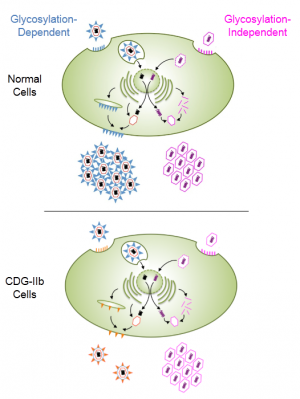Viruses (blue and pink) must use host cells (green) to create more viruses that spread infection (top panel). CDG-IIb patients have defective glycosylation, the process of adding sugars to proteins, resulting in poor production of viruses that depend on this process, such as HIV and influenza (bottom panel). The scientists also show that viruses coming from the patients' cells (orange) are less infectious because of changes to their outer shields. Credit: NIAID
A National Institutes of Health (NIH) study reports that a rare genetic disease, while depleting patients of infection-fighting antibodies, may actually protect them from certain severe or recurrent viral infections. Researchers found that HIV and influenza viruses replicate in the cells of people with congenital disorder of glycosylation type IIb (CDG-IIb) at a much lower rate than in healthy donor cells, creating fewer and less infectious viruses. The study, published in The New England Journal of Medicine, was led by Sergio Rosenzweig, M.D., Ph.D., director of the Primary Immune Deficiency (PID) Clinic at the NIH's National Institute of Allergy and Infectious Diseases (NIAID).
In the study, the researchers diagnosed CDG-IIb in two siblings with severe development issues who were referred to the NIAID PID Clinic though the NIH Undiagnosed Diseases Program. CDG-IIb is extremely rare, with only one other case reported. The genetic defect of the disease disrupts glycosylation, or the process of attaching sugars to proteins. As a result, proteins called gamma globulins, which include infection-fighting antibodies, are unstable and persist at low levels in the patients' blood.
Interestingly, some viruses, including HIV and influenza, depend on glycosylation to form protective shields. The researchers showed that these viruses were less able to replicate or create protective shields because of the glycosylation defects in CDG-IIb cells. In comparison, adenovirus, poliovirus and vaccinia virus, which either do not rely on glycosylation or do not form protective shields, replicated normally when added to both CDG-IIb and healthy cells. This study suggests that modulating aspects of host glycosylation may be a strategy to control certain viral infections.
More information: MA Sadat, S Moir et al. Glycosylation, hypogammaglobulinemia and resistance to viral infections. NEJM, DOI: 10.1056/NEJMoa1302846 (2014).
Journal information: New England Journal of Medicine


















